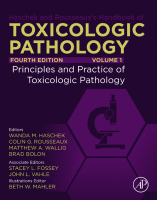Physical Address
304 North Cardinal St.
Dorchester Center, MA 02124

1 Introduction In order to develop new agrochemicals, industrial chemicals, and pharmaceutical products, regulatory agencies worldwide require preclinical safety evaluation trials in order to determine toxicity and pharmacokinetics. International guidelines typically recommend studies in at least two species, one rodent…

1 Introduction Throughout modern biomedical research, the rabbit has remained a core laboratory animal species. Studies using rabbits have provided important insights into toxicology, immunology, reproduction, and other fields. Interestingly, despite their common use, many key factors about rabbit biology,…

Acknowledgments Noah's Arkive images are provided by courtesy of the Charles Louis Davis and Samuel Wesley Thompson DVM Foundation for the Advancement of Veterinary and Comparative Pathology (hosted at ) and are reproduced under a Creative Commons BY-NC-SA license.…

1 Introduction General texts concerning statistics ( ; ; ; ; ; ; ; ; ) are available; however, this chapter has been written as a practical guide to common statistical problems encountered when using differing research strategies in toxicologic…

Acknowledgments We would like to acknowledge the work of the authors in the previous edition of this chapter “The Application of Toxicogenomics to the interpretation of Toxicologic Pathology” by William R. Foster, Donald G. Robertson, and Bruce D. Car in…

1 Introduction Biomarker discovery has rapidly progressed from a classical empirical approach to a high-priority, technology-supported research activity. According to the Food and Drug Administration's (FDA) Biomarkers, EndpointS and other Tools glossary ( ), a biomarker is a defined…

Acknowledgments The authors are grateful for figure contributions for this chapter. We would like to thank Dr. Robert Maronpot and Dr. Robert Sills of NIEHS, Dr. Alan Johnson of the Duke University Center for In vivo Microscopy, Dr. Marty Pomper, Dr.…

1 Introduction The age of digitalization has arrived in light microscopy. While the current practice of toxicologic pathology remains largely based on the light microscopic evaluation of stained tissue sections, it is no longer limited to it. Thanks to the…

1 Introduction Advances in cell and molecular biology have engendered a wide range of techniques to investigate mechanisms of disease or toxicity that can be used to augment traditional morphologic tools used in toxicity testing. In the team-oriented scientific world…

1 Introduction 1.1 Value of Clinical Pathology Testing Clinical pathology testing is a key component of nonclinical safety studies that evaluate the potential toxicity of test articles including therapeutic agents (new chemical entities and biologics), pesticides, and industrial chemicals to…